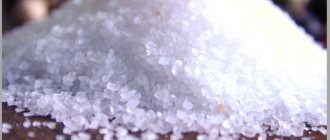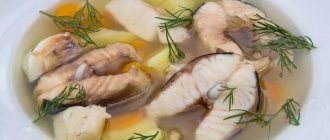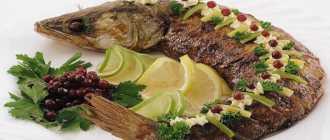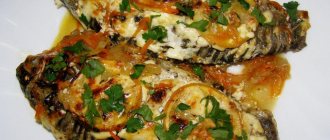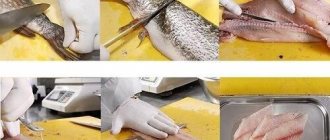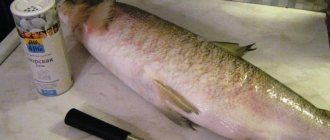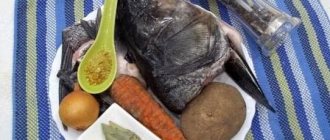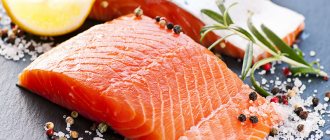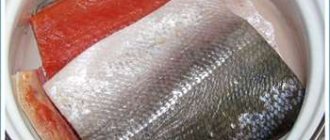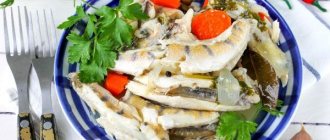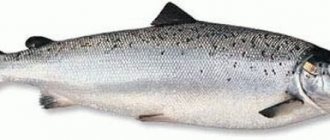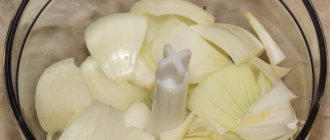Chinook salmon – where does it live and how is it useful?
Chinook salmon lives in the Anadyr River, Kamchatka, Amur and northern Hokkaido. Very common along the American coast, in Alaska and in the Arctic. The taste of the fish is close to salmon, but at the same time it is less fatty and high in calories (148-150 kcal per 100 g), it can be used with dietary and gentle nutrition. First you need to know what Chinook fish looks like.
- The standard color scheme is bright silver flanks, white belly, and blue-green or olive back. Chaotically scattered dark spots covering the top of the body, tail and both fins. During the spawning period, light colors change to burgundy and pink.
- The fish has a very expressive appearance: a long body, ventral fins moved back, small scales.
- The sides of the carcass are compressed, the head and mouth are large, and the eyes are small. On the back there are two fins without spiny rays.
There are contraindications that are associated with individual intolerance to salmon products, gout, and pancreas problems. Regular consumption of chinook salmon prevents the accumulation of cholesterol plaques, reduces the risk of hypertension, diabetes, heart failure and the development of eye diseases. Meat and caviar contain many elements that are beneficial for the heart, blood vessels, vision, joints, muscles, and nervous system:
- polyunsaturated fatty acids;
- selenium;
- natural antidepressants;
- vitamins B9, B12, C, D, E, PP;
- phosphorus, calcium, iron;
- magnesium, potassium, sodium.
How to cook chinook salmon?
Chinook fish, the recipes for which are extremely simple and hassle-free. Knowing how to cook salmon or sockeye salmon, you can adapt your favorite dish for this fish, but the resulting treat will be much tastier. Chinook salmon is juicy, moderately fatty with dense but tender meat.
- Chinook salmon is easy to salt; you can use dry salting, marinade, and spices: dry herbs, some spices.
- Fish in soup, steamed, stewed with vegetables is delicious.
- Chinook salmon is baked in the oven in foil, a sleeve, under marinade or cheese. You can also use steaks and ready-made fillets.
- Fried Chinook salmon is good without breading. Cutlets made from rolled minced meat are incredibly tasty and juicy.
- Fish exhibits its qualities well as a main or delicious ingredient for salads, sandwiches, canapés, and appetizers. Thanks to its beautiful appearance combined with a delicate, dense structure, you can prepare mouth-watering dishes.
Chinook salmon lightly salted at home
Having figured out what kind of Chinook fish, the first thing cooks do is salt the fillet. Due to the high fat content, it is advisable to salt the fish using the dry method, preserving the unique taste. Chinook salmon is not salted quickly - 2 days, and thanks to the addition of a small amount of alcohol it acquires a delicate structure and pronounced taste; vodka can be replaced with brandy or rum. For spicy salting, add dry dill, fennel seeds, bay leaf and pepper.
Ingredients:
- fillet with skin – 1 kg;
- coarse salt – 5 tbsp. l.;
- sugar – 2 tbsp. l.;
- vodka – 60 ml.
Preparation
- Rinse the fillet, dry with a paper towel and coat with vodka, leave to soak for 10-15 minutes.
- Mix salt and sugar.
- Rub the fillet with the curing mixture on all sides.
- Place skin side down in a glass or enamel bowl.
- Lightly salted Chinook remains under pressure for 40 hours.
How to cook chinook salmon in a frying pan?
Having figured out what kind of Chinook fish it is, even a teenager can fry it in a frying pan. Frying 1 kg of fish will take no more than 20 minutes. Both fillets and steaks will do. Many chefs do not recommend mixing different types of oils for frying. Fats have different boiling points; when mixed, they form carcinogens faster, and they are absorbed into foods more strongly. Therefore, it is better to use regular vegetable oil without bitterness.
Ingredients:
- Chinook salmon steaks – 1 kg;
- oil for frying;
- salt and black pepper;
- sweet pepper, tomato – 1 pc.;
- lettuce and basil, pesto for serving.
Preparation
- Steaks, rinse, dry with a towel.
- Sprinkle with salt and pepper.
- Fry in a grill pan with olive oil for 7 minutes on each side.
- Chinook salmon fried in a frying pan and sprinkled with lemon juice.
- Next, fry the pepper rings and tomato slices.
- Serve with lettuce and roasted vegetables, topped with pesto sauce.
Chinook salmon cutlet recipe
This fish does not have small bones, so the fillet is perfect for making chinook fish cutlets; the recipe below is very simple. You don’t need to add lard to the minced meat to make the dish juicy; onions and garlic are enough for taste and aroma. From half a kilogram of fillet you get about 8-10 cutlets. Breadcrumbs, ground chips and flakes are suitable for breading.
Ingredients:
- Chinook salmon fillet without skin – 500 g;
- onion – 150 g;
- garlic – 3 cloves;
- yolk – 1 pc.;
- breading – 5 tbsp. l.;
- bread – 100 g;
- water – 50 ml;
- salt pepper.
Preparation
- Soak the bread in water.
- Pass the fillet through a meat grinder.
- Twist the soggy bread, squeezing out the water, onion and garlic. Add yolk, salt, pepper and mix.
- Make cutlets and bread them.
- Fry on both sides.
Chinook salmon in the oven - recipe
Baked chinook salmon in the oven in foil goes well with potatoes, which easily absorb fat and turn out very tasty. This fish goes well with onions, carrots and tomatoes. Before baking, you don’t have to lubricate with sauces or limit yourself to low-fat yogurt. Thanks to the fat, an appetizing crust will appear. You can use thyme, rosemary and lemon spices for fish..
Ingredients:
- Chinook salmon – 1 kg;
- potatoes – 400 g;
- onions – 2 pcs.;
- carrots – 1 pc.;
- pepper, salt;
- bay leaf – 1 pc.;
- lemon – 0.5 pcs.;
- yogurt – 100 g;
- dill – 20 g;
- vegetable oil – 10 ml.
Preparation
- Rub the fish with salt and pepper and sprinkle with juice.
- Cut the onion into half rings, carrots into strips.
- Boil the potatoes until half cooked. Cool and cut as desired.
- Place the fish on a baking sheet. Place potatoes, cover with chopped onions and carrots.
- Mix sour cream with salt and dill and pour over fish.
- Bake for 50 minutes.
Chinook salmon on the grill
The aromatic chinook salmon recipe offered below is a delicious treat with a smoky aroma. To make the fish juicy, it is recommended to bake it in foil. Then the pulp is steamed and soaked in spices and herbs. To make the fish more tender, add lemon slices. It is not recommended to marinate for more than half an hour, otherwise the pulp will soften too much. For piquancy, you can mix lemon juice with orange juice.
Ingredients:
- chinook salmon – 6 steaks;
- lemon – 2 pcs.;
- sour cream – 3 tbsp. l.;
- onions – 2 pcs.;
- pepper – 1 tsp;
- salt – 1 tsp;
- vegetable oil – 3 tbsp. l.
Preparation
- Mix seasonings and rub all steaks.
- Sprinkle with lemon and leave for half an hour.
- Chop the onion and place in packages with the steaks.
- Add a couple of lemon slices.
- Spread with sour cream and seal in foil.
- Bake on coals for 30 minutes.
Chinook salmon in a slow cooker
Delicious aromatic chinook salmon - a recipe that is ideal for dinner. The fish has tender and dense flesh that does not lose its structure during cooking and retains its elasticity. The proposed option involves serving it with vegetables with which the Chinook salmon was stewed. It is appropriate to supplement with slices of lime and pour over the resulting juice.
Ingredients:
- chinook salmon (fillet) – 700 g;
- tomatoes – 4 pcs.;
- lime – 1 pc.;
- olives – 150 g;
- garlic – 1 clove;
- salt, pepper, oregano, thyme and thyme
- olive oil – 4 tbsp. l.
Preparation
- Cut the fillet. Heat the oil in a bowl over “Fry” and place the fish skin side down.
- Finely chop the olives. Crush the garlic, cut the tomatoes into slices.
- When the fish turns light, add olives, garlic, and tomatoes.
- Salt and season.
- Cut the lime in half, squeeze out the juice and pour over the fish.
- Cook on “Stewing” for 30 minutes.
Chinook salmon soup - recipe
Fish lovers will undoubtedly enjoy Chinook salmon soup or fish soup cooked with the addition of a simple and cheap set of vegetables. For thickness, you can supplement the composition with rice or millet. The broth will be richer if you fry the vegetables before adding them to the pan. The fish soup is prepared from the head, but it is better to add other bone parts: ridge, tail and flesh.
Ingredients:
- bone parts of chinook salmon – 300 g;
- potatoes – 1 kg;
- onions – 2 pcs.;
- carrots – 2 pcs.;
- oil;
- salt, pepper, bay, herbs.
Preparation
- Boil the fish for 30 minutes, adding one onion and one carrot each.
- Strain the broth.
- Add potatoes, and after 10 minutes sauté vegetables, fish, and all seasonings.
- Cook for 15-20 minutes, serve with herbs.
Chinook salmon salad
Salted red Chinook fish is an excellent ingredient for light, low-calorie salads. The appetizer is prepared from vegetables, iceberg leaves, and celery adds freshness. Supplemented with grated carrots, beets, and chopped cucumber, the salad will become brighter and more original. Oil is added to taste; if it seems that the dish lacks juiciness, you can only add lemon juice when serving.
Ingredients:
- celery stalks – 2 pcs.;
- fresh cucumber – 1 pc.;
- salted chinook salmon – 150 g;
- beets and carrots – 0.5 pcs.;
- iceberg lettuce;
- salt, pepper, oil, lemon, olives.
Preparation
- Tear the salad with your hands, mix with tuna, grated carrots, beets and chopped celery.
- Divide the mixture into plates in portions, add cucumber slices, chopped olives and lemon slices.
- Season with salt, pepper, oil and lemon juice.
Secrets and useful tips
There are several secrets, armed with which you don’t have to worry about the quality of the finished Chinook fish:
- The right choice is a 50% guarantee of a quality dish. When buying fish in a store, you need to make sure that it has not been frozen before. This is easy to do by eye: the Chinook salmon flesh should not be watery and have a dense, soft structure.
- If you decide to fry chinook salmon in a frying pan, then you should do it in a well-heated frying pan and not for long. This will allow a crust to appear, which will retain all the juices inside the fish. If you keep it on the fire, the fat will evaporate, and the result will be dry and completely unattractive.
- Chinook salmon itself has a rich flavor. When baking it, you don’t need to use a huge amount of spices and seasonings. You just need to highlight the taste with lemon slices and the result will be juicy, tasty fish with a unique aroma.
- When salting, you should also not overuse spices. Many cooks categorically refuse to use even pepper, not to mention multiple seasonings. On the other hand, if funds allow, you can experiment and get interesting results. The only exception is paprika. She will completely ruin the Chinook salmon. But lemon zest can highlight the taste.
- Need lightly salted fish quickly? A little more sugar and it will absorb the brine faster. However, it is better to eat such chinook salmon right away. It is stored much worse.
- Finally, not everyone knows how to properly cut fish. To easily remove the ridge, you need to make a cut along it, as well as two at the very base of the tail. Now, with a slight movement, the sirloin is removed from the bones.
Knowing all the nuances of choosing and preparing chinook salmon, an experienced housewife can always prepare a wonderful dish with minimal effort and expense.
Chinook salmon is one of the most expensive seafood on the market today. Despite this, its popularity is only increasing every year.
It has not only excellent taste, but also a lot of useful properties that have a beneficial effect on the general condition of the body. Salting and cooking Chinook fish is a simple and fun process that leads to amazingly tasty results.
Beneficial features
The nutritional value of Chinook salmon is high. At the same time, its usefulness surpassed all other sea fish.
- Firstly, it is rich in protein: 100 grams contain as much as 20 grams. squirrel. It can more than become an element of dietary nutrition, since the percentage of fat in it is significantly less than other salmon.
- Secondly, Chinook salmon contains all the vitamins and microelements necessary for the body. Its regular consumption can reduce the risk of dangerous diseases (heart failure, strokes, depression and much more).
- Thirdly, it normalizes the functioning of the brain (which is especially important for people whose work is associated with active mental activity) and internal organs, and also prevents the appearance and development of quite serious diseases.
Such fish is a real vitamin “boom”. It is not surprising that its use is recommended by all experts. In its meat you can find:
- vitamins A, B, C, E, K
- copper
- zinc
- manganese
- magnesium
- iron
- phosphorus
- potassium
In addition, Chinook salmon caviar can improve vision, improve blood circulation, as well as strengthen bone tissue and reduce the risk of blood clots.
There are no serious contraindications to eating fish. These include only individual intolerance to meat or an allergic reaction to caviar. People suffering from diseases of the gastrointestinal tract should be wary of Chinook salmon.
You should also not abuse it. Despite all the benefits, a large amount of fish every day can cause deterioration of digestive processes.
Chinook salmon is not a cheap fish, but it won’t hurt to dilute your usual daily diet at least once a month. The body will say a huge “thank you” for this by improving the functioning of the immune system.
The benefits and harms of Chinook salmon
The positive effects of fish are:
- in the prevention of destructive and atrophic processes in the brain organs associated with age-related changes;
- in reducing the risk of developing sclerosis, Alzheimer's disease, dementia;
- in providing a positive effect on the functioning of the cardiovascular system;
- in improving blood circulation in the body;
- in strengthening bone tissue, reducing the likelihood of blood clots or osteoporosis.
- DHA ensures normal functioning, regulates the normal functioning of the human visual organs, normalizes the functioning of the nervous system and produces new nerve cells, ensures the timely removal of toxic components from the body and provides adequate nutrition to the body's cells.
- EPA maintains vascular tone and, thanks to the production of bioactive elements in the body, provides protection against the occurrence and progression of severe pathologies.
The negative qualities of fish include the possibility of allergic reactions, especially during pregnancy in women. However, according to statistics, the occurrence of these reactions is recorded in one out of 250 cases, which is a low rate
. Caution in consuming meat or fish roe should also be exercised by people with stomach problems and chronic diseases of the gastrointestinal tract.
How to pickle chinook salmon at home
The simplest recipe for preparing Chinook salmon is dry-salting the fillet. Lightly salted chinook salmon can be added to salads, snacks, even simple sandwiches will be incredibly tasty.
I suggest trying an unusual recipe with the addition of vodka (you can use rum or brandy), which will make the meat more tender.
You will need:
- 1 kg. – fish fillet
- 2 tbsp. spoons - coarse salt
- 1 tbsp. spoon (a little less is possible) – granulated sugar
- 60 ml. – vodka
- Spices (dry dill, fennel seeds, bay leaves, peppercorns) - to taste
How to cook:
1. Rinse the fish fillet well with cold water, dry with a paper towel, rub with vodka, and leave to marinate for 15 minutes.
2. In a separate bowl, mix salt and granulated sugar and rub well with the resulting mixture.
3. Place in a large glass (enamel) bowl, skin side down, add any spices to your taste, cover the fish with a lid, plate or cling film.
4. Place in the refrigerator for 48 hours, now you can taste it.
Calorie content per 100 g. – 148 kcal
Bon appetit!
How to cook chinook salmon in a frying pan
The frying process will not take you much time - about 15 minutes will be enough, and you will have a delicious dinner ready. And it's best to cook on a grill pan.
You will need:
- 3-4 pcs. – steak or pieces of Chinook salmon fillet
- Olive oil – for frying
- Salt, spices, pepper - to taste
- Half a fresh lemon
- 1 piece each – large red tomato and sweet bell pepper
- Fresh lettuce leaves - for a beautiful presentation of the dish
How to cook:
1. Wash the fish, dry it, sprinkle with salt and spices, fry in a frying pan in vegetable oil for about 5-7 minutes on each side.
2. While the fish is frying, cut the peeled pepper into rings and tomatoes into slices.
3. Wash the lettuce leaves, dry them, and place them beautifully on a serving plate.
4. Place the finished fish on lettuce leaves and sprinkle with lemon juice.
5. Fry the vegetables in the same frying pan and add to the fish. Everything is ready, you can set the table.
Note to the hostess! In the same way, you can fry this fish on the grill. To make the fish more juicy, each piece should be wrapped in foil.
Calorie content per 100 g. – 231 kcal
Bon appetit!
About Chinook salmon.
Chinook salmon, the largest subspecies of fish in the salmon family, is a very valuable fish with the most delicate pulp, comparable in consistency to butter. The aroma of fish does not have a bright fishy expression, characteristic, for example, of pink salmon or chum salmon.
The flesh of chinook salmon has a high fat content, it is pliable, but at the same time elastic to the touch, has a rich red-orange hue, since the basis of its diet are marine crustaceans, shrimp, cephalopods and small fish.
Chinook salmon spend most of their lives at sea, returning to rivers only to spawn, after which they mostly die.
In the sea, before the first spawning, Chinook salmon can “walk” in different ways; some individuals gain weight for about 8 years, moving 4000 kilometers from their spawning grounds.
There is also a dwarf variety of Chinook salmon; these are migratory males that do not go far into the sea and spend no more than a year near their native river, and then go to spawn. The dwarf variety of chinook salmon reaches a weight of no more than 1.5 kilograms, but the average weight of marine centenarians is 25 kilograms; there are cases of catching fish weighing more than 60 kilograms.
Fish spawning in Kamchatka.
Fish spawning in Kamchatka.
Chinook fish is a prominent representative of salmonids
Other names for this fish of the salmon family include the American description of chinook salmon as the “king of salmon” and the Japanese name translated as “prince of salmon.”
Judging by the names of the synonyms, people not only value the important economic significance of Chinook salmon, but also, naming it with similar epithets, respect it for its size, cunning, swiftness, and power.
Chinook salmon habitat
According to the ichthyological classification, the fish belongs to the freshwater species. However, Chinook salmon spend a significant part of their life outside fresh waters, far from their birthplace
. The habitat of this fish is localized between the West Coast of the Pacific Coast of the United States and the northern part of the Japanese Islands, Kamchatka and the Kuril Islands.
Some of the population is found in the fresh water of the rivers of British Columbia, Washington, and on the territory of the Russian Federation in the basins of the Anadyr and Amur rivers.
Recently, breeding Chinook salmon on artificial farms and in places atypical for their residence, for example the Great Lakes (USA), and reservoirs of New Zealand, has become popular.
Description of Chinook
The main difference between this fish and other members of the family is its significant weight compared to other members of the species. The average weight of fish is about 6-17 kg, some fishermen managed to catch specimens weighing about 30 kg, while the established record for the weight of Chinook salmon is more than 60 kg
. Its length on average ranges between 85 and 115 cm, rarely reaching 1.5-2 m.
Among the external features, a distinctive feature is the presence on the body of the fish of large stripes on the line between its head and body. The color of this representative of salmon depends on its habitat and ranges from light gray to greenish-silver, olive hue.
The ventral and lateral parts of the fish are silver in color. On the sides, located above the lateral line of the Chinook salmon, on the surface of the back, dorsal and caudal fins there are black spots of small size
. During the spawning period, the fish changes color, darkening in the head area and acquiring a rich brown tint in the body area.
Another distinctive feature of the species are small spots located on the surface of the back, fins and tail. On the other hand, the fish does not have the X-shaped spots and pink stripes on the surface of the skin characteristic of the family.
Life cycle and reproduction
The life cycle of a fish consists of:
- birth in a freshwater body;
- life in a reservoir until the age of two;
- going to sea and living in it for the next 3-5 years;
- return to the place of birth to implement the reproduction function.
Individual representatives of the species, distinguished by their small sizes from 10 cm to half a meter, related to males, reach the period of sexual readiness, skipping the stage of going to sea, and can take part in spawning together with other males.
As a rule, for spawning, fish choose small rivers along which they can ascend from the mouth to the spawning site, covering a distance of up to 4000 km. The reproduction process itself is somewhat extended in time and lasts under normal conditions from June to August, and in the conditions of North America it also occurs in the autumn-winter period.
While living in rivers, its diet includes:
- various larvae;
- insects;
- some types of young fish;
- small crustaceans.
In sea conditions, the Chinook menu consists of:
- crustaceans;
- cephalopods;
- small fish;
- plankton;
- krill.
Composition of Chinook salmon meat
Chinook salmon meat is valued both from the point of view of the content of substances that regulate the flow of processes important for human health, and from the point of view of its culinary and taste characteristics. Fish contains a huge amount of vitamins B1, B2, C, PP, K, E, microelements such as selenium, zinc, potassium, calcium, phosphorus, magnesium, iron, sodium, molybdenum, nickel, chromium, fluorine.
Chinook salmon is characterized by a fairly high content of proteins (up to 20/100g) and fatty acids such as choline and Omega 3, which are necessary for the body, but are not produced by it.
In particular, we are talking about docosahexanoic (DHA) and eicosapentaenoic (EPA) acids, which perform the functions of supporting cell membranes and ensuring the normal functioning of metabolic processes in the body. Meat, like fish roe, has a high degree of digestibility, which allows the cells of the body to make maximum use of the beneficial substances of chinook salmon.
The caviar of this fish is distinguished by a specific bitter taste and the large size of individual eggs, reaching 6-7 mm in diameter. At one time, Chinook salmon lay up to 14 thousand eggs.
The fish is characterized by a lower fat content compared to other members of the family, 11-13.5%. Its meat, which has a rich red color with a raspberry tint, resembles salmon in taste, but with a certain cooking method it is valued much higher than it.
Just like for fish meat, the nutritional and energy value of fish largely depends on its living conditions, age, gender, and time of fishing. The calorie content of fish is about 146 kcal/100 g of product.
Nutritional and energy value:
| Ready meals | |||
| kcal 1410.8 kcal | proteins 141.3 g | fat 48.1 g | carbohydrates 111.5 g |
| Portions | |||
| kcal 470.3 kcal | proteins 47.1 g | fat 16 g | carbohydrates 37.2 g |
| 100 g dish | |||
| kcal 61.3 kcal | proteins 6.1 g | fat 2.1 g | carbohydrates 4.8 g |
How to choose Chinook salmon
Here are some tips to help you choose the right fresh fish in a store or market and avoid becoming a victim of unscrupulous sellers:
1. A fresh carcass (if it is not packed in a bag) has the aroma of the salty sea; it should not emit an unpleasant odor.
2. The meat is red or pink, there may be a slight raspberry tint, but not brown or gray. Do not buy fillets with a bright red or dark red color; in this case, special dyes were used to hide the quality or age of the fish.
3. The body of the fish should be elastic and return to its original form when pressed.
4. The ability of this fish to accumulate harmful substances (especially mercury), it is better to purchase small carcasses.
5. King salmon caviar is bright red in color with egg size up to 7 mm. Highly valued by gourmets, with a rich taste, thin shell, and a slight bitter aftertaste.
6. The price of a fresh frozen carcass without a head is about 700 rubles, fillet (steak) is about 1300-1500 rubles, caviar is about 5000-6000 rubles. per kilogram.
Chinook steak
At what temperature and for how long should I bake?
It doesn’t take much time for the Chinook salmon to cook. Steaks are cooked at a temperature of 180 degrees for 25-35 minutes depending on their size, at a temperature of 200 degrees - 20-30 minutes.
Medium pieces of fillet (weighing 0.2-0.3 kg) are baked for the same amount of time as steaks. If fillet pieces weigh less than 200 g, then they need to be baked for 5 minutes less than large ones. Large pieces of fillet weighing about 0.5 kg should be cooked 5-10 minutes longer.
Sometimes the cooking time of a dish is affected by its composition, since some of the ingredients may require longer cooking. In order to avoid mistakes and get the expected result, it is advisable to focus on the recommendations that accompany a specific recipe.
Freezing recipe
• For freezing, the fillet is cut into thin slices, without skin, laid out in layers in a jar, ground pepper is added between the layers and the whole thing is filled with sunflower oil. The jar goes into the freezer, where it will definitely not spoil within a year. • The main thing to remember is that salted fish should be defrosted at a low temperature; it is advisable to move the jar from the freezer to the refrigerator in advance for 5-6 hours and there it will thaw without releasing water and maintaining the original appearance of the product.
So, let's remember the important points:
1. We only take frozen Chinook salmon; if you have fish from the shore, then we freeze it for at least 3 days. 2. When cutting, we use a sharp tool. 3. If you are going to salt chinook salmon at home, be sure to wash it with cold water, preferably salted. 4. When gutting fish, pay special attention to the bloody groove along the spine, from the abdomen. 5. It’s better to fillet any salmon when it’s frozen, so it’s easy to remove the spine with all the rib bones at once. 6. If we want the Chinook salmon to be lightly salted, we don’t get carried away with salt. In this case, we use only coarse salt. 7. We select an oppression that is 2 times greater than the weight of the prepared fillet (in my case, 3.6 kg of fillet, eight kilogram oppression). Without pressure, the fish takes much longer to salt, and we risk getting a product with a flavor. 8. Defrost the fish after storing it in the freezer in a cool place.
Chinook salmon is a wonderful fish that simply has no equal. Unfortunately, due to its size and the enormous volumes of red caviar for salmon per individual, it has been practically exterminated in Russia. But if you still manage to purchase this fish and salt it as recommended in this recipe, you will definitely not be disappointed.
Share on social media networks
Similar articles
About the special taste and nutritional value.
During my student years, I was lucky enough to work in practice at the Moscow central grocery store No. 40, where in the fish shop they cut up huge chinook salmon, it seemed to me then that it was not a fish, but a whale. Chinook salmon was delivered in wooden barrels with a capacity of 300 liters, each barrel contained only two fish. We watched with all our eyes as real professionals processed these giants by hand.
The fish was filleted and then cut with special knives into very thin, almost transparent slices, which were then covered with special wax paper. Each slice was the size of a good plate, the taste of that fish was simply amazing, the flesh was tender, oily, with a subtle fishy aroma.
On average, high-quality chinook salmon weighs from 5 to 8 kilograms, the weight of caviar is from 1 to 2 kilograms, the caviar is always bright red, large, with a delicate shell of the eggs. The milk of males is also highly valued; for example, in Japan and China the price of milk is much higher than that of caviar. Milk is fried in breading, pies are baked with it, they are even eaten raw, dipped in vinegar and soy sauce, there are lovers of fish hearts and livers, soups are made from these ingredients, they are fried, pickled and smoked.
It is not recommended to cook broth from the backbones of Chinook salmon; the same goes for sockeye salmon; these two species of salmon, unfortunately, are capable of accumulating unwanted toxins in the backbone.
Chinook salmon fillet in a curing mixture.
Chinook salmon fillet in a curing mixture.
How to properly salt royal salmon.
Fish production technologists use a very small amount of ingredients to salt chinook salmon, not wanting to overpower the natural, delicate aroma of the fish with bright spices; paprika is especially contraindicated; it can impart bitterness and an unpleasant metallic taste to the fish pulp.
Chinook salmon is salted mainly in a dry way, using salt, sugar and a mixture of peppers, and strong alcohol is never added to the salt mixture; it “brews” the delicate fish flesh and gives the fish an unpleasant herring taste.
Also, do not use soy sauce and ginger, these components can clog the taste of the fish.
But deodorized vegetable oil, on the contrary, is very often used to avoid weathering and soften the top layer of fish pulp.
Video recipes
Chinook Salmon Video Recipe – Chinook Salmon Steak with Mashed Potatoes
Chinook salmon video recipe – Chinook salmon with vegetable mix
Chinook salmon video recipe – Chinook salmon with onion and cream sauce
Chinook Salmon Video Recipe – Chinook Salmon Soup with Yogurt
Chinook salmon video recipe – Chinook salmon steak with potatoes in the oven
Two simple recipes to note for the housewife
Chinook salmon is cooked extremely rarely, however, despite this, there are many interesting and tasty recipes. Let's consider the two easiest and, at the same time, delicious.
Chinook salmon with vegetables in the oven
Chinook salmon is a delicious fish. Especially if you cook it according to the original recipe, with vegetables in the oven. What you need for a tasty result:
- Chinook steak (6 pcs.)
- tomato (5 pcs.)
- one medium onion
- cauliflower (1 head or 300 gr.)
- sweet pepper (2 pcs.)
- olive oil and soy sauce (3 tbsp each)
- half a lemon
- greenery
- coarse sea salt
- spices
Thanks to the vegetables, the result is excellent, juicy Chinook salmon. Oven cooking recipes may differ in ingredients, but the technology remains the same.
Chinook salmon in the oven
So, let's begin the process of creating a culinary masterpiece. The first thing we pay attention to is the steaks. They must be prepared. If the fish is whole, then it must be divided into even pieces, after gutting it.
It is worth saying that its scales are very small, so most indigenous peoples of the North prefer not to peel them.
Take a deep bowl where we will prepare the dressing. To do this, combine soy sauce, olive oil, lemon juice and prepared spices. After the marinade is ready, immerse the fish in it, sprinkled with sea salt.
While the Chinook salmon is marinating, it's time to get started on the vegetables. Sweet peppers and onions need to be cut into rings. We do the same with tomatoes: chop them into circles. We separate the cauliflower into inflorescences and pour boiling water over them thoroughly to remove the bitterness.
Place vegetables on a baking sheet lined with foil in even layers. The sequence is not important. They need to be drizzled with olive oil and sprinkled with a small amount of spices.
Place pieces of chinook salmon on the “vegetable bed” and wrap foil around the edges. In an oven preheated to 180-200 degrees, such a fish should be baked for 20 minutes. Serve in portions, garnished with a small amount of herbs.
Stuffed Chinook
Another interesting recipe, actively used by chefs, will allow you to prepare the “king of salmon” in an original way. What is needed for this:
- 1 kg chinook salmon
- 50 gr. fresh bread
- 150 ml milk
- one egg
- 1 kg onion
- one small beet
- 0.5 kg carrots
- 80 gr. butter
Prepare the fish as in the first recipe. Then we separate the fillet from the bone and pass it through a meat grinder along with two onions. Add a piece of bread, previously soaked in milk, and an egg to the resulting minced meat. Add salt and mix.
Cut the remaining chinook into pieces and lightly fry in butter. Stuff each piece with the resulting mass. Cut the rest of the onions into rings, grate the beets and carrots on a coarse grater.
Place in a saucepan with a wide bottom. Place pieces of stuffed fish on the resulting “pillow”. There should be exactly 1 cm more water.
Cook for about an hour over medium heat. Season with salt or pepper if necessary. Delicious stuffed fish is ready!
As you can see, chinook salmon is prepared not only easily, but also quickly. The result will definitely please both household members and possible guests.
Salting Chinook salmon at home
Many people don’t even realize how appetizing Chinook fish can be. Pickling recipes from skilled chefs will correct this shortcoming. So, for the classic method you will need to prepare:
- 1 kg chinook salmon
- 1 liter of clean water
- 90 gr. salt
- allspice
- lavrushka
- Art. l. ordinary table vinegar
- vegetable oil (50 ml). medium bulb
First you need to cut the fish. We get rid of the head, entrails and bones. Many people prefer to leave the bones: it takes less time and effort.
However, it is better to do this right away than to suffer with the bones at the festive table later. Cut the finished fillet into small slices and place neatly in a bowl.
Now let's start preparing the brine. Pour 0.5 liters of water into a container and add salt. Stir until it is completely dissolved. Fill the fish with salt water and place under a small press. This will prevent it from floating. We leave everything on the table for an hour and a half.
When the time is up, drain all the water, and instead fill the fish with a glass of water with vinegar diluted in it. Let it sit for another 5 minutes, after which this filling must be removed.
Cut the onion into rings or half rings. Add 2 bay leaves, oil and a few peppercorns to it. Pour everything into the fish and mix well. Lightly salted chinook salmon is ready. This method of salting does not take much time and does not require huge financial costs. What else does an enterprising housewife need?
There is another interesting, simpler method for salting chinook salmon at home. There are very few ingredients and all are available:
- 1 kg chinook salmon
- 120 gr. salt
- two packs of peppers (peas and regular)
- two bay leaves
The first step is preparing the fillet. We clean the fish of all excess. Rinse well.
Bring 0.5 liters of water to a boil. Here we throw salt, allspice and bay leaf. So the brine is cooked for another 5-7 minutes over low heat, after which it is removed from the stove and cooled to room temperature.
Place the Chinook salmon fillet into a container and fill it with the resulting brine. Cover and leave to steep in a cool place for 10-15 hours. Delicious fish is ready.
If long-term storage is required, then all the pieces must be poured with vegetable oil and then pour in 1 tsp. table vinegar dissolved in a glass of water. Mix everything well, place in a jar and close tightly.
The process of salting fish is fascinating and interesting. Even the most fastidious gourmet will like this chinook salmon.
How to salt red fish can be seen in the video:
Recipe for “Lightly salted Chinook salmon at home”
• First of all, we kick out the cat, who was freaking out while I was jumping with the camera, and decided that it was covered especially for him (animal lovers, please don’t worry, he will get it too, but later).
• Cut the fillet into equal pieces, layer thickness, 10-15 centimeters wide. • Making the mixture for salting:
• Mix salt and sugar 3 to 2 (chinook “loves sugar”, I will soon publish a recipe for “royal salting”, which is dry and most suitable for this type of salmon). Add seasoning for salting fish, I usually take two different types. One just for fish, the second specifically for red fish. If there are no seasonings, it will be enough: salt, sugar, pepper and dried herbs (parsley, dill).
• Knead the mixture so that there are no lumps of salt and mix thoroughly. As stupid as it may sound, careless cooks often end up with fish that is sweet on one side and over-peppered on the other precisely because of such a trifle.
• Sprinkle the mixture on both sides of our fillets. You shouldn’t skimp on salt, but it’s also not advisable to drown fish in it. The phrase “the fish will take as much as it needs” is definitely not suitable for this type of salting, especially for tender Chinook salmon. In addition, salt is needed to absorb excess moisture, and not to impart a special taste; chinook salmon is fine without it.
• Take a pan (bucket, barrel, etc.), if you salt the fish so that it comes out lightly salted, you don’t need to fill the bottom with salt. We lay out our fillet pieces in layers, throwing 2-3 bay leaves between the layers. It is important to remember that the layers are laid out with the scales facing down; if the meat touches, it will stick together.
• Press with a press. It would be better if it pressed not only on the center, but occupied most of the area of our pan. But at the same time, it was not close to the walls, otherwise during the salting process, the released juice would go beyond the edges. • Place the dough in the refrigerator for 40 hours. Under pressure in the refrigerator, the fillet is compressed, which prevents the formation of air pockets in the meat where bacteria can grow. • I usually salt chinook salmon in the evening, in the morning it’s ready within 24 hours, but according to GOST, salting needs to take 40 hours, no less. I would like to note that the salting time is not universal and other varieties of salmon take longer to salt. The fact is that Chinook salmon meat is very tender and, as I already said, this is a noble salmon, so 1.5-2 days is the optimal time for it to be fully prepared and acquire a lightly salted taste. If you want to pickle coho salmon and need a recipe, here is the link. • Take the pan out of the refrigerator, try it, enjoy. Then everything depends on your needs. You can cut the fillet into thin layers for sandwiches or rolls, you can chop it into cubes for salad or tartare, and if in your case the delicacy needs to be preserved for a long time, chinook salmon should be frozen.
Preparation:
Every third recipe says that before salting fish, you should not wash it. The salting technology is really based on replacing plain water with salt water (2-3%), because... plain water is a medium for the spread of bacteria, which is highly undesirable when salting. But if we decide to salt fish at home, this can be neglected. Especially if you have a whole carcass, you definitely need to wash it and you shouldn’t be afraid of anything.
If the fish is gutted, you can wash the inside with a weak saline solution at room temperature, then let the water drain and wipe dry with dry gauze (rag). Personally, I wash my house under simple running water and in 15 years I have never had any problems associated with this. The main thing is not to wash it in warm water, because... this will have a detrimental effect on the taste.
Chinook salmon cutting
Any cook who has tried to salt fish at least once will confirm that the most difficult thing is preparing the fillet. I would like to point out right away that it is very important to have a sharp knife, otherwise it will be a disaster and you will suffer. It is also convenient to use scissors when cutting. I make 2 preparations from whole chinook salmon, one for soup, the other for salting. • The head and tail are cut off.
• The fins are cut with scissors; I cut them with a piece of meat 3-5 cm (in the photo), because These are the fatty parts of fish, which definitely won’t hurt your ear. • The abdomen is cut open and all the insides are removed. • Important, pay attention to the strip of blood along the entire spine; it must be removed, otherwise poisoning may occur. • Next comes the most difficult part: an incision is made along the ridge and the spine is removed along with the ribs. If the chinook salmon has already been lying down and the meat is quite soft, then everything is more difficult, it is better to cut it into 2 layers, on the first layer the spine with all the ribs should be easily stretched out with pliers, from the second layer you will have to remove the bones individually, with pliers or by prying them with a knife (if you are too lazy, you can remove the bones with a long knife, simply cutting them along the inside of the ribs, along with a small layer of meat, in the photo I did this, because I have an abundance of Chinook salmon).
• As a result, we should have 2 sets
• First on the ear: head, tail, fins, I also left a small piece of meat from the tail, because the ear should also have at least a little meat besides the broth, and I don’t have any other fish for this.
• We will now salt the second one: exclusively fillet with skin, without bones
Description
Coho salmon belongs to the Salmon family. The fish is quite large and can reach up to 1 m in length, with a weight of about 15 kg. Depending on its habitat, the fish may have different parameters. Distinctive characteristics include bright silver scales (see photo), which is why this fish is also called “silver salmon.” Coho salmon also have a fairly large head with a wide forehead and a high caudal peduncle. They love this red fish for its tender and juicy meat. On store shelves you can find fresh, frozen, as well as salted and smoked fish, and canned fish is also made from it.
How to choose?
It is very important to know the rules for choosing coho salmon so that the dish from it turns out tasty and healthy. Here are the main ones:
- Look at the scales, they should be bright, shiny, and tightly adjacent to the meat. If you see spots, bruises and unevenness, these are signs of poor quality fish.
- If you buy fish steaks, then choose those that are on ice.
- Press down on the surface of the fish; the resulting hole should quickly recover. Otherwise, you should refuse the purchase.
- If you buy a whole carcass, then look at the eyes of the fish, they should not be cloudy.
- Feel the carcass, it should be a little damp, but in no case sticky.
Beneficial features
The benefit of coho salmon lies in its chemical composition. It contains a large number of vitamins, among which group B stands out, which is important for metabolism and for the normal functioning of the nervous system. This fish also has a rich mineral composition. It is recommended to consume coho salmon for pregnant women, children, and people with anemia, as the fish increases the level of hemoglobin in the blood. This product contains omega-3s, which are important for the cardiovascular system and brain activity.
Use in cooking
Coho salmon is used in cooking to prepare numerous dishes. Many famous restaurants have this fish. It can be subjected to various heat treatments, but baked coho salmon is considered the most delicious. Another delicious dish is shish kebab made from this fish. Properly cooked grilled coho salmon turns out delicious and literally melts in your mouth. You can make a delicious roll, soup, and numerous snacks from this fish.
How to cook delicious Coho salmon fish?
Coho salmon, like other products, has its own characteristics in preparation. If you want to cook a delicious dish, then you must follow them:
- If you are using frozen fish, you should first defrost it so that the carcass becomes flexible. To do this, leave it in the refrigerator for a while and only then leave it at room temperature. Using a knife or scissors, cut the fish into steaks.
- If you want to fry fish, you must first roll it in flour and salt. Place the pieces cut side down on a hot frying pan. The fish is fried quickly, a couple of minutes on each side is enough.
- If you are grilling coho salmon, you can pour beer or wine over the steaks, but the original taste of the fish will be lost. But many will like the new original taste. Cooking coho salmon on the grill will take no more than 10 minutes. Steaks must be turned constantly. Before serving, sprinkle the fish with lemon juice and garnish with herbs.
- The best additions to this fish are garlic, soy sauce, herbs and spices.
Harm to coho salmon and contraindications
Coho salmon can cause harm if an individual intolerance to the product is detected. You should avoid such fish if you have gastritis and liver problems. Pregnant women should not eat fish in large quantities.
Video: Coho salmon - what kind of fish, where it lives, benefits, how to cook
IT WILL BE INTERESTING:
Fresh and canned cod liver: composition, calorie content, benefits...
Tilapia (tilapia): what kind of fish, where it is found, composition, calorie content, gender...
Mullet: what kind of fish, where it is found, composition, calorie content, benefits
Yellowtail lakedra: what kind of fish, photo, description, where it is found, what...
Navaga: composition, calorie content, daily norm, how to choose, benefits and harms
Chinook: what kind of fish, photo, description, where it is found, how to cook, how...
Seaweed: benefits and harms, medicinal properties for men and women
Grenadier (hoki): what kind of fish, photo, description, where it is found, how it is prepared...
Sockeye salmon: what kind of fish, where is it found, composition, calorie content, description, usefulness...
Previous entry: Brushwood – 8 of the simplest, crispiest and most delicious recipes Next entry: Coho salmon fish – 11 of the most delicious cooking recipes
Appearance
Chinook salmon differs from other fish in its special appearance. It has a strong and strong torpedo-shaped body, a fairly large head, and black gums on the lower jaw. Chinook salmon are not distinguished by their bright colors. Its dorsal part is olive-colored, and its belly and sides are light silver.
One of the features of the external appearance of this fish is a dark stripe running between the body and head. Like other fish of the salmon family, the appearance of Chinook salmon changes during the mating season. Her body turns brown and her back turns black.
Earlier we talked about other fish. Here you can see a photo of Marinka fish.
How big does Chinook salmon get?
As mentioned earlier, Chinook salmon reaches quite large sizes. In addition to being the largest salmonid fish, Chinook salmon are also the largest freshwater fish in the Northeast region. The weight of Chinook salmon varies from six to seventeen kilograms, and its length ranges from 75 to 105 centimeters.
The benefits of Chinook salmon for humans.
Fish contains many elements beneficial to humans, but they depend on various factors. For example, one can cite habitat and age; gender also matters.
But despite this, there are certain permanent vitamins. The main ones are calcium (22 mg), copper (41 mcg), phosphorus (200 mg), magnesium (27 mg), potassium (394 mg), etc. Omega-3 acids are present.
The main feature of fish is that the fats are unsaturated, that is, they will not be stored as excess weight. Chinook salmon contains selenium, which slows down the aging process in the body. One 100g serving contains 148 calories, caviar contains 250.
Chinook salmon has the property of preventing heart attacks and strokes. Caviar helps improve vision and bone tissue.
About contraindications for Chinook salmon
You should not eat Chinook salmon if you are allergic to red fish, but if you have diseases of the intestines and pancreas, you can eat it a little. True, there is never too much Chinook salmon - it is not cheap, and allergic reactions to it are extremely rare. Large Chinook salmon, and especially those raised in fish factories, can accumulate harmful substances.
Chinook salmon is an anadromous fish of the Salmon family with a torpedo-shaped body. It is the largest not only among its relatives, but also among all fish of the North-Eastern region.
On average, Chinook salmon grows to 80-100 centimeters and weighs 10-20 kilograms. The largest representatives of the genus live near Kamchatka. They grow in length up to 150-180 centimeters and reach 40-60 kilograms of weight.
During the spawning period, fish of both sexes develop fang-like teeth, and males also become covered with red spots. Due to its enormous size, Americans call Chinook salmon king salmon.
, and the Japanese - “the prince of salmon”
.
This amazing fish is also often called aquatic titanium.
Ingredients for “Chinook salmon in aromatic seasoning with garnish”:
- Fish (red, in this case chinook) - 600 g
- Apple (fresh) – 2 pcs.
- Parsley (for seasoning) - 1 bunch.
- Dill (for seasoning) - 1 bunch.
- Garlic (for seasoning) - 2 cloves.
- Tomato (for seasoning) - 1 pc.
- Salt (to taste)
- Black pepper (to taste)
- Cauliflower (small, side dish) - 1 fork
- Carrots (medium size, garnish) - 1 pc.
- Mushrooms (fresh or frozen, garnish) - 200 g
- Soy sauce (garnish) - 2 tbsp. l.
- Sesame oil (garnish) - 2 tbsp. l.
- Lemon juice - 3 tsp.
Number of servings: 3
What kind of Chinook fish is it and how to prepare it according to delicious recipes?
Those who don’t know what kind of Chinook fish are will be interested to know how valuable this fish is and the dishes made from it are simply extraordinary. This fish is a large representative of the Pacific salmon genus; its dimensions exceed pink salmon, coho salmon, and sockeye salmon. Due to its impressive size, Chinook salmon are often called princely or king salmon.
Chinook salmon fishing
In Russia it is found on the northeast coast. Here it is considered the largest of all known freshwater fish. In Kamchatka, individuals weighing from 6 to 17 kg are usually caught. The length of the body can be from 70 to 100 cm.
Like all representatives of the salmon family, this species is born in clean, fresh river water. One female is capable of laying up to 20,000 eggs. When young individuals grow up, they go to the cold waters of the ocean.
Recently, this breed began to be bred artificially in New Zealand and the USA. This happens in natural fresh water bodies.
We also recommend reading:
Composition of Chinook salmon meat
First of all, the nutritional value of Chinook salmon meat depends on the content of proteins and fats in it, as well as on the yield of edible parts.
The chemical composition of meat determines the taste of chinook salmon and its nutritional value, which depends on the content of water, fat, minerals and nitrogenous substances, as well as vitamins and carbohydrates in the fish.
Although the chemical composition of fish meat is not a constant value, since it significantly depends on the age and sex of the fish, environmental conditions, fishing time and the physiological state of the fish itself, its meat always contains substances and products of fat and protein metabolism that regulate important life processes in the human body.
The energy value of Chinook salmon meat is 148.4 kcal.
Chinook salmon meat contains vitamins B1, B2, C, PP, as well as such valuable substances as potassium, calcium, iron, magnesium, sodium, phosphorus, chlorine, molybdenum, nickel, chromium, fluorine and zinc, unsaturated fatty acids.
Spawning and feeding of individuals
During spawning, Chinook salmon acquire a bright mating color. All representatives of the salmon family change their appearance. The body takes on a reddish-brown hue, the back becomes black, and the transverse stripes on the back disappear. The proportions of the body do not change, but there is a curvature of the jaws in males and the appearance of teeth in fish of both sexes.
Compared to other salmon, the mating color of Chinook salmon does not look so bright and expressive. Small juveniles can be confused with coho salmon.
To spawn, the individual enters rivers and can travel up to 4 thousand km. The search for a suitable place for breeding fish begins in May. Spawning occurs from June to August. The female digs a hole in the pebbles and spawns higher upstream, where they are fertilized by the males. After this, it swims to the prepared nest. Later, the hole is filled up, but the fry remain inside for about six months. At one time, Chinook salmon can lay up to 14 thousand eggs.
For the first 2 years, the young live in fresh water, then move to the ocean or sea, and only after 5 years return to the rivers. Before leaving, they gather in flocks. They feed on insect larvae, small fish and small crustaceans. And in the depths of the sea and ocean they eat squid, planktonic crustaceans, cephalopods, krill, and also small fish.
Adults that go to spawn stop feeding. They use reserves accumulated in the ocean, but at first they retain a grasping reflex.
Salmon steak in a frying pan recipe
It would seem that there is no simpler recipe than the one that describes how to fry fish. But, if you cook it at home, and not on a camping trip, while on a fishing trip, and you also bought noble salmon, then you want to please yourself and your loved ones with a culinary masterpiece. Therefore, today we will learn: how to fry salmon steak in a frying pan.
Important subtleties
The key to a delicious lunch or dinner is the right choice of product. You can purchase ready-made steaks or cut up a fish carcass.
In any case, pay attention to the quality: fresh fish has dense, elastic flesh. However, more often we take frozen salmon, and here it’s worth taking a closer look at the color of the flesh. Too pale is evidence that the product has been repeatedly thawed and frozen again - you definitely won’t get juicy steaks.
Extremely bright, should also arouse suspicion - unscrupulous suppliers have learned to artificially color ordinary cheap varieties of fish (especially if it is presented on the counter without a head, fins, tail and other identifying parts), passing it off as representatives of the noble salmon family.
You only need to fry salmon in a well-heated frying pan with a fairly thick bottom so that it heats up evenly. It’s even better if you have a grill pan at home. These utensils will help you cook steaks with a perfect crust. You can also cook red fish in the oven.
Don’t try to use a “sea” of seasonings - high-quality salmon is good on its own and will be flavorful without any tricks. Two spices that are almost always present in all salmon recipes are black or (white) pepper and lemon. Citrus emphasizes the bright taste of salmon and gives it a piquant flavor.
On average, the thickness of a portioned piece should be 2-2.5 centimeters. Too thin can turn into something like chips - dry and hard, despite all your efforts. And thick ones quite often turn out overcooked on the outside and damp, as if steamed on the inside, but not at all juicy.
Simple and tasteful!
First, the simplest recipe: how to cook salmon steak in a frying pan. For 4 servings you will need: 4 steaks, vegetable oil (refined, deodorized) for frying, juice of half a lemon, salt and pepper to taste, a tablespoon of butter.
We wash the semi-finished fish products under cold water, dry them, and rub them with salt and pepper. Take a clean frying pan without any remaining fat from previous dishes. The fish is so delicate that it instantly “acquires” all the odors, and in our case, by design, the aromas are completely undesirable.
Heat a frying pan with vegetable oil; it’s easy to check the degree of readiness for frying - the water that gets on the surface of the dish will hiss. And we put in our steaks. Don't try to fry all the pieces at once. It is advisable that there is space between them, otherwise they do not fry, but rather steam, and we will not achieve the desired result - a crispy crust and juicy pulp.
How long to fry? Alas, even experienced housewives often make the mistake of believing that the degree of readiness of fried fish depends on its color. Remember, salmon steaks 2 centimeters thick are fried for 3-4 minutes on each side, over moderate heat!
Remove the finished fish from the heat, place on a plate and pour over lemon juice. While the dish has not cooled down, place a piece of butter on top. It will give a delicate, creamy taste.
I foresee an important question: should salmon be dredged in flour? This option is acceptable in most recipes. In this way we “seal” the salmon so that its juice and aroma are better preserved. You can also use breadcrumbs. However, everything is optional.
Novice cooks try to experiment by mixing different types of fats during the frying process. For example, vegetable oil and margarine, while claiming that fried fish in such a “plate” simply melts in your mouth.
But nutritionists are against such recipes because different types of fats have different boiling points, and therefore dangerous carcinogens are actively released during the cooking process, and the dish itself absorbs more fat and becomes unnecessarily heavy.
Secret from an expensive restaurant
In the middle of the last century, one of the Warsaw restaurants became famous for the fact that the chef fried amazingly tasty “red” fish. But it so happened that his secret soon became the property of many culinary specialists. And here's how to cook salmon steak according to a Polish chef's recipe.
In addition to four portioned pieces of fish, you need: vegetable oil, cucumber, 250 grams of classic unsweetened yogurt, salt, lemon, garlic.
Using tweezers, remove the bones from the washed and dried steaks. Sprinkle with lemon juice. After heating the pan, add the salmon, fry and add salt at the very end of cooking. The fact is that salt promotes the release of moisture and juice, and we need to preserve all the taste of the fish.
The subtlety is that in this recipe we do not turn the steaks over, but pour boiling fat over them in the process.
As soon as the fish becomes noticeably paler on top, try pressing the piece with a knife; if clear juice comes out, you’re done! And now the most important thing is the sauce - mix the grated cucumber with yogurt, add some salt, add finely chopped garlic.
The ideal side dish in this case is simple boiled potatoes and lettuce, on which, by the way, the steaks are placed. This is how the food looks exquisite, “restaurant style.” As you can see, everything ingenious is surprisingly simple.
Marinade for steaks
Sometimes fish is marinated according to a recipe, but not to make it soft, but in an attempt to enrich its taste with additional aromas.
How to marinate salmon steak? It’s not difficult at all: pepper the prepared fish, generously sprinkle with lemon juice, salt, add a few sprigs of dill (not chopped!), and leave at room temperature for about fifteen minutes.
While let's make the sauce: melt 3 tablespoons of butter in a convenient bowl, add half a grated apple and 3 chopped leeks (the white part), a little salt, and white pepper. Leave all the ingredients on the fire, stirring for 5-10 minutes. It all depends on how juicy the apple turns out to be (it is better to take green varieties). Let's bring to a boil.
Remove the marinated steaks from the dill (the herb will burn in the pan) and fry in olive oil on each side for 3-4 minutes. Serve with rice and fresh vegetables, seasoned with apple onion sauce. A very spicy dish that will not go unnoticed at any home banquet.
Three delicious recipes
Source: https://www.shampurok.ru/stejk-iz-lososya-na-skovorode/
Where and how to catch Chinook salmon
According to experts, fish are considered the most valuable when they have not yet begun to ascend the river to their spawning grounds. But there is a danger of its uncontrolled fishing, which can lead to a significant decrease in the population of this tasty and healthy fish.
Most fishermen note that Chinook salmon is a rather cunning and cautious fish. They claim that the fish choose parking areas that are difficult to reach from a fishing point of view.
Fish grown artificially contains more harmful substances, so catching it in such places is not recommended. In such cases, preference should be given to individuals caught in natural conditions.
Fishing in Kamchatka Chinook salmon fishing June 2013
